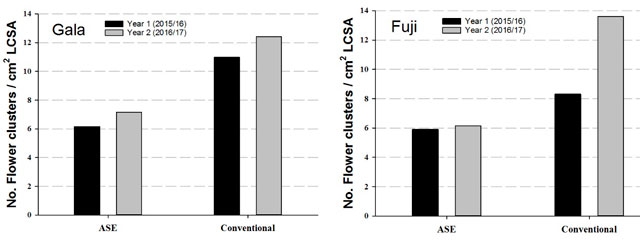Artificial Spur Extinction (ASE) is a crop load management method using bud thinning techniques to precisely define where and how much fruit is set on each limb of the tree.
What is ASE? (continued from last month)
Artificial Spur Extinction (ASE) is a crop load management method using bud thinning techniques to precisely define where and how much fruit is set on each limb of the tree.
The aim of ASE is to promote the vigour and performance of floral spurs, stimulate spur strength and improve fruit quality and regularity of production.
Initial setup
The initial setup of trees for ASE begins with winter pruning to remove unbalanced (large) limbs and space limbs out so there is a maximum of 6-7 limbs per metre of tree height.
To optimise fruiting whilst restricting excessive vegetative growth, remaining limbs are trained to a near horizontal position.
Floral spurs are then selectively removed prior to bud break to precisely define the density and location of potential fruit on the tree.
The number of flower buds left on each limb is based on the diameter of the limb, so that a strong branch carries more fruit and vice versa.
This means that at bud burst ASE managed trees commence spring growth in an already significantly ‘crop thinned’ state, carrying fewer but stronger flower buds than conventionally managed trees.
As there is less competition, more resources are directed to fruit buds that will go on to produce fruit rather than thinnings on the ground.
ASE also simplifies and speeds up the job of hand thinning as spacing, position and number of clusters are already set by the bud thinning process—all that is required is to break up fruit bunches and remove fruit with defects.
About the trials
All trees were pruned during winter; unbalanced limbs were removed and then remaining limbs spaced out to six limbs per metre of tree height.
On the ASE trees, floral buds were thinned to six buds cm-2 limb cross-sectional area (LCSA) in late August just prior to bud break.
A full chemical thinning program, using the bloom thinners Ethrel® (ethephon) and NAA and post-bloom thinner Maxcel® (BA), was undertaken on trees tagged for chemical thinning.
Following natural fruit drop, all trees were hand-thinned nine weeks after full bloom (FB), to six fruit cm-2 limb cross-sectional area (LCSA). Fruit was harvested at normal commercial harvest.
Flowering and fruit set
As noted above, in ASE managed trees the number of flower buds (clusters) is reduced prior to bud burst, resulting in fewer buds than in conventionally managed trees.
This is clearly seen in Figure 1 which shows floral cluster numbers in both the Gala and Fuji trials across the two years of the trial.
Conventional trees were carrying approximately double the number of flower buds at bud break compared with the ASE managed trees.
The other important point to note is that the number of clusters in the ASE trees was stable across the two years.
In the first year, a high proportion of clusters set fruit in these trials—the result of an unusual season with a very short compressed flowering period.
Flowering in the second season (2016–17) was spread over a longer period (about four weeks) and a more conventional pattern of fruit set was observed (Figure 2), with chemical thinning reducing the proportion of clusters set in both Gala and Fuji.
Under conventional tree management it is not uncommon to see 30-50% of spur and terminal buds failing to set fruit.
(continues next month)
See this article in Tree Fruit Oct 2017






















